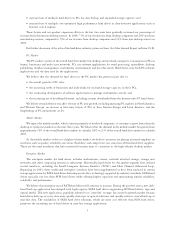Western Digital 2006 Annual Report Download - page 21
Download and view the complete annual report
Please find page 21 of the 2006 Western Digital annual report below. You can navigate through the pages in the report by either clicking on the pages listed below, or by using the keyword search tool below to find specific information within the annual report.Our prices and margins are subject to declines due to unpredictable end-user demand and oversupply of hard drives.
Demand for our hard drives depends on the demand for systems manufactured by our customers and on storage
upgrades to existing systems. The demand for systems has been volatile in the past and often has had an exaggerated effect
on the demand for hard drives in any given period. As a result, the hard drive market has experienced periods of excess
capacity which can lead to liquidation of excess inventories and intense price competition. If intense price competition
occurs, we may be forced to lower prices sooner and more than expected, which could result in lower revenue and gross
margins.
Our failure to accurately forecast market and customer demand for our products could adversely affect our business and
financial results.
The hard drive industry faces difficulties in accurately forecasting market and customer demand for its products.
The variety and volume of products we manufacture is based in part on these forecasts. If our forecasts exceed actual
market demand, or if market demand decreases significantly from our forecasts, then we could experience periods of
product oversupply and price decreases, which could impact our financial performance. If our forecasts do not meet actual
market demand, of if market demand increases significantly beyond our forecasts, then we may not be able to satisfy
customer product needs, which could result in a loss of market share if our competitors are able to meet customer
demands.
We also use forecasts in making decisions regarding investment of our resources. For example, as the hard drive
industry transitions from the Parallel Advanced Technology Attachment (“PATA”) interface to the SATA interface, we
may invest more resources in the development of products using the SATA interface. If our forecasts regarding the
replacement of the PATA interface with the SATA interface are inaccurate, we may not have products available to meet
our customers’ needs.
In addition, although we receive forecasts from our customers, they are not obligated to purchase the forecasted
amounts. In particular, sales volumes in the distribution channel are volatile and harder to predict than sales to our OEM
customers. We consider these forecasts in determining our component needs and our inventory requirements. If we fail to
accurately forecast our customers’ product demands, we may have inadequate or excess inventory of our products or
components, which could adversely affect our operating results.
Increases in areal density may outpace customers’ demand for storage capacity, which may lower the prices our customers are
willing to pay for new products.
Historically, the industry has experienced periods of increased areal density growth rates. Although in recent years
there has been a decrease in the rate of areal density growth, if industry conditions return to periods of increased growth
rates, the rate of increase in areal density may exceed the increase in our customers’ demand for aggregate storage capacity.
Furthermore, our customers’ demand for storage capacity may not continue to grow at current industry estimates as a
result of developments in the regulation and enforcement of digital rights management or otherwise. These factors could
lead to our customers’ storage capacity needs being satisfied with lower capacity hard drives at lower prices, thereby
decreasing our revenue. As a result, even with increasing aggregate demand for storage capacity, our ASPs could decline,
which could adversely affect our results of operations.
A low cost structure is critical to our operating results and increased costs may adversely affect our operating margins.
A low cost structure for our products, including critical components, labor and overhead, is critical to the success of
our business and our operating results depend on our ability to maintain competitive cost structures on new and
established products. If our competitors are able to achieve a lower cost structure for manufacturing hard drives, and we
are unable to match their cost structure, we could be at a competitive disadvantage to those competitors. Additionally,
there are costs for certain commodity materials, an increase in which increases our costs of manufacturing and
transporting hard drives and key components. For example, shortages of materials such as steel and aluminum increase
our costs and may result in lower operating margins if we are unable to find ways to mitigate these increased costs. The
rising cost of oil also increases our costs and may result in lower operating margins if we are unable to pass such increased
costs through to our customers.
15
























